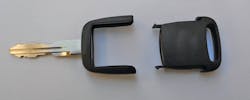Editor's Note: Click on the related contact tab to download our complete Cloning 2012 Keys chart in pdf format.
There are two basic types of transponders. “Fixed” value transponders are designed for on-board programming or device programming when connected to the diagnostic port pf the vehicle. The terminology “fixed” incorporates both Fixed and Encrypted Transponders. They cannot be cloned.
The second type is the clonable transponder, designed to have a new value duplicated onto the chip using an existing compatible transponder. Cloning can only take place when using a clonable transponder.
Whether a transponder has a fixed value or is clonable cannot be determined visually. If the transponder is molded into the plastic head of the key blank, the part number can be used to identify the type of transponder. Sometimes the shape of the head can be used to identify the type of transponder.
A limited number of transponder-equipped keys can be programmed to a vehicle. This number determines how many transponder keys can be programmed. Since a cloned key is a duplicate of an already programmed key, there is no limit on the number of cloned keys that can be used to operate a vehicle. Cloning a clonable key does not affect any of the programmed keys.
Cloning saves time; there is no limit to the number of cloned keys and if the programmed key (master or valet) operates the vehicle, the cloned key should have no problems operating the vehicle. In addition, vehicle PIN codes are not needed to clone a key.
For most vehicles, there is no need to go to the vehicle. However, for Philips Crypto (#46) transponders, vehicle access is required. The Philips Crypto transponder-based engine immobilizer systems are used in many of the later model vehicles.
There are different types of transponders designed for cloning keys. Original Equipment Manufacturer (O. E. M.) type chips are ceramic or a glass ampoule, and can come molded into the key blank head. The O.E.M. style transponder can be sold separate from the key blank. This type of transponder can only be used in a key blank that has accommodations for installing these types of transponders.
The circuit board type is larger and incorporates a generic style head. Depending upon the manufacturer and model, the head can be a separate component or attached to the blade. The circuit board style is further divided by those that have a battery and those that are battery less. Battery replacement times are determined by the manufacturer.
O. E. M. style transponders or those with the battery less circuit board receive power from the vehicle’s antenna ring surrounding the ignition lock. Those with the battery equipped circuit boards receive power from their internal battery.
A number of aftermarket key blank manufacturers sell programmable and clonable key blanks. Some produce their own programming devices and cloning machines; others produce programming devices and cloning machines, but do not manufacture key blanks.
Important: No standalone cloning machine can clone every aftermarket clonable key. This is because the transponders used by the different providers are not all identical.
There are different types and styles of clonable transponders. Most of the generic “TP5” type transponders can be cloned over and over again. Some can be cloned only once. Others can be cloned a limited number of times.
Clonable keys can have a transponder with a pre-cloned value or no value. The manufacturer usually determines this. One reason for pre-cloning a clonable transponder is to prevent damage to a vehicle’s computer system when a no value clonable key is programmed to the vehicle instead of cloned.
A pre-cloned transponder is known as a rewritable transponder. The value will change when it is cloned using another compatible transponder-equipped key.
To determine the identification of a clonable key, use a transponder detector or a cloning machine with readout display. When the transponder is read, pre-cloned keys display their cloned value and transponder type.
Some of the not so good things having to do with clonable transponders are the limitations and costs. Approximately 85 percent of vehicle’s keys can be cloned.
A clonable key cannot capture the unique programming features of a specialized transponder equipped key/fob that personalizes the vehicle. For example, some vehicle keys will adjust the seat, mirrors and the radio stations. In addition, since there are no buttons on a clonable key, it cannot unlock the doors or trunk, or open the sliding doors or tailgate.
A clonable key blank is more expensive than a “fixed” value transponder equipped key blank.
The final consideration is that many of the clonable key blank/cloner manufacturers’ products are not totally compatible with other manufacturers’ equipment.
In the accompanying chart, I have included an alphabetical list of clonable key blank numbers from Bianchi, Ilco, Jet and JMA USA. I would like to thank the key blank manufacturers for their help to produce this key blank chart. This list is a work in progress, as I have not been able to examine every clonable vehicle make, model and year. I apologize for any error or omissions to this chart.
Jet Hardware is in the process of introducing their new cloning machine and new line of clonable key blanks incorporating the iCLONE Transponder Technology. The new cloning machine will clone both the existing Jet clonable key blanks and the new clonable key blanks. A future article will be written discussing the iCLONE Transponder Technology.






